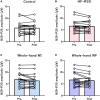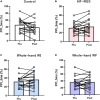Effect of whole-hand water flow stimulation on the neural balance between excitation and inhibition in the primary somatosensory cortex
- PMID: 36393986
- PMCID: PMC9640458
- DOI: 10.3389/fnhum.2022.962936
Effect of whole-hand water flow stimulation on the neural balance between excitation and inhibition in the primary somatosensory cortex
Abstract
Sustained peripheral somatosensory stimulations, such as high-frequency repetitive somatosensory stimulation (HF-RSS) and vibrated stimulation, are effective in altering the balance between excitation and inhibition in the somatosensory cortex (S1) and motor cortex (M1). A recent study reported that whole-hand water flow (WF) stimulation induced neural disinhibition in the M1. Based on previous results, we hypothesized that whole-hand WF stimulation would lead to neural disinhibition in the S1 because there is a strong neural connection between M1 and S1 and aimed to examine whether whole-hand WF stimulation would change the neural balance between excitation and inhibition in the S1. Nineteen healthy volunteers were studied by measuring excitation and inhibition in the S1 before and after each of the four 15-min interventions. The excitation and inhibition in the S1 were assessed using somatosensory evoked potentials (SEPs) and paired-pulse inhibition (PPI) induced by single- and paired-pulse stimulations, respectively. The four interventions were as follows: control, whole-hand water immersion, whole-hand WF, and HF-RSS. The results showed no significant changes in SEPs and PPI following any intervention. However, changes in PPI with an interstimulus interval (ISI) of 30 ms were significantly correlated with the baseline value before whole-hand WF. Thus, the present findings indicated that the whole-hand WF stimulation had a greater decreased neural inhibition in participants with higher neural inhibition in the S1 at baseline. Considering previous results on M1, the present results possibly show that S1 has lower plasticity than M1 and that the duration (15 min) of each intervention may not have been enough to alter the balance of excitation and inhibition in the S1.
Keywords: paired-pulse inhibition (PPI); primary somatosensory cortex (S1); repetitive somatosensory stimulation; somatosensory evoked potentials (SEP); whole-hand water flow stimulation.
Copyright © 2022 Le Cong, Sato, Ikarashi, Fujimoto, Ochi and Yamashiro.
Conflict of interest statement
The authors declare that the research was conducted in the absence of any commercial or financial relationships that could be construed as a potential conflict of interest.
Figures








Similar articles
-
No effect of whole-hand water flow stimulation on skill acquisition and retention during sensorimotor adaptation.Front Hum Neurosci. 2024 Jun 7;18:1398164. doi: 10.3389/fnhum.2024.1398164. eCollection 2024. Front Hum Neurosci. 2024. PMID: 38911224 Free PMC article.
-
Whole-hand water flow stimulation increases motor cortical excitability: a study of transcranial magnetic stimulation and movement-related cortical potentials.J Neurophysiol. 2015 Feb 1;113(3):822-33. doi: 10.1152/jn.00161.2014. Epub 2014 Nov 5. J Neurophysiol. 2015. PMID: 25376780
-
Modified ischaemic nerve block of the forearm: use for the induction of cortical plasticity in distal hand muscles.J Physiol. 2019 Jul;597(13):3457-3471. doi: 10.1113/JP277639. Epub 2019 Jun 6. J Physiol. 2019. PMID: 31111966
-
Locating primary somatosensory cortex in human brain stimulation studies: systematic review and meta-analytic evidence.J Neurophysiol. 2019 Jan 1;121(1):152-162. doi: 10.1152/jn.00614.2018. Epub 2018 Dec 5. J Neurophysiol. 2019. PMID: 30517062
-
Cortical excitability in human somatosensory and visual cortex: implications for plasticity and learning - a minireview.Front Hum Neurosci. 2023 Aug 17;17:1235487. doi: 10.3389/fnhum.2023.1235487. eCollection 2023. Front Hum Neurosci. 2023. PMID: 37662638 Free PMC article. Review.
Cited by
-
No effect of whole-hand water flow stimulation on skill acquisition and retention during sensorimotor adaptation.Front Hum Neurosci. 2024 Jun 7;18:1398164. doi: 10.3389/fnhum.2024.1398164. eCollection 2024. Front Hum Neurosci. 2024. PMID: 38911224 Free PMC article.
References
LinkOut - more resources
Full Text Sources
Research Materials
Miscellaneous

